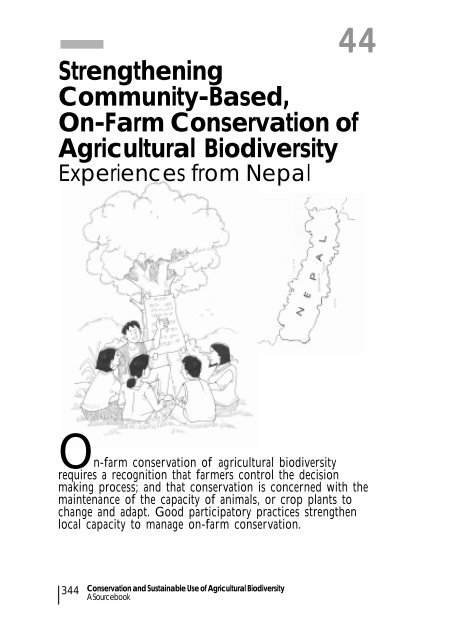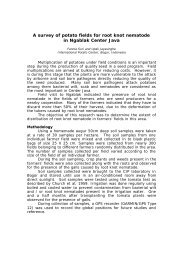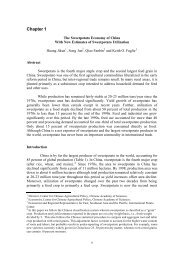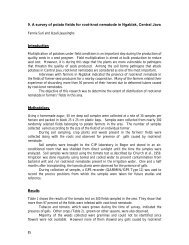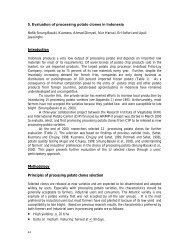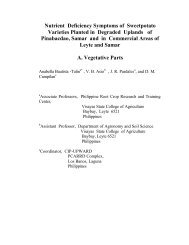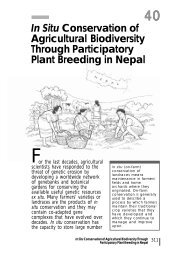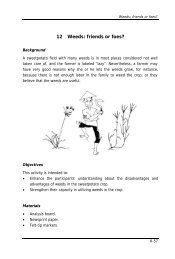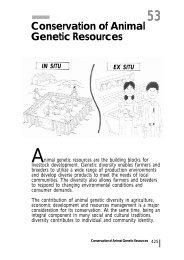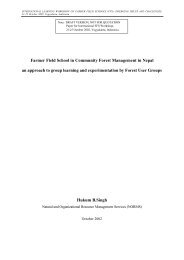Strengthening Community-Based, On-Farm ... - cip-eseap
Strengthening Community-Based, On-Farm ... - cip-eseap
Strengthening Community-Based, On-Farm ... - cip-eseap
Create successful ePaper yourself
Turn your PDF publications into a flip-book with our unique Google optimized e-Paper software.
44<strong>Strengthening</strong><strong>Community</strong>-<strong>Based</strong>,<strong>On</strong>-<strong>Farm</strong> Conservation ofAgricultural BiodiversityExperiences from Nepal<strong>On</strong>-farm conservation of agricultural biodiversityrequires a recognition that farmers control the decisionmaking process; and that conservation is concerned with themaintenance of the capacity of animals, or crop plants tochange and adapt. Good parti<strong>cip</strong>atory practices strengthenlocal capacity to manage on-farm conservation.344Conservation and Sustainable Use of Agricultural BiodiversityA Sourcebook
Good practices are those practices,that are practical, cost-efficient,sustainable, and have the potentialfor scaling up in widergeographical, institutional andsocio-cultural context.Several practices have been testedfor effective implementation ofthe above-mentioned steps.However, the following areconsidered good practices forcommunity-based on-farmconservation in Nepal:! parti<strong>cip</strong>atory extent andGood practice is asystem, organization orprocess, which, overtime maintains,enhances and createscrop genetic diversity,and ensures theiravailability to andfrom farmers andother actors forimprovedlivelihoods on asustainable basis(UNEP/IPGRI,2002).distribution (four square diversity) analysis;! social seed networks;! parti<strong>cip</strong>atory community sensitization;! diversity fairs;! diversity blocks;! diversity kits;! community biodiversity register; and! parti<strong>cip</strong>atory plant breeding.General Steps Needed to Strengthen <strong>Community</strong>-<strong>Based</strong>,<strong>On</strong>-<strong>Farm</strong> Conservation of Agricultural BiodiversityDevelop understanding of local context and local diversitySensitize farming communities and key stakeholdersImprove access to materials and knowledgeLocate, characterize and assess diversityManage community biodiversity information systemsfor monitoring diversityDevelop options of adding benefits to communityIncrease consumer demand for rare, threatenedand traditional crops and food cultureImprove the materials and creating newopportunities for livelihoods<strong>Strengthening</strong> <strong>Community</strong>-<strong>Based</strong> <strong>On</strong>-<strong>Farm</strong> Conservation of Agricultural Biodiversity:Experiences from Nepal345
Social Seed NetworkThe informal seed system is a keyelement of on-farmconservation of local cropdiversity. This is integratedinto a social network ofrural communication.Some farmers maintain arelatively large range ofdiversity, search for newdiversity, select, maintainand share within andoutside the community.Such farmers areconsidered to be the"nodal farmers" of thecommunity.Recently, the local CBO Development and EnvironmentProtection Club (DEPC) has recognized the nodal farmers inNepal. They can be effectively involved in communitybiodiversity registration (CBR) and linked to developmentopportunities.Parti<strong>cip</strong>atory <strong>Community</strong> Sensitization<strong>Community</strong> parti<strong>cip</strong>ation is central to the community-based,on-farm conservation of agricultural biodiversity and use.<strong>Community</strong> parti<strong>cip</strong>ation can be strengthened throughsensitization of farming community and consumers throughpublic awareness. However, this strategy for in situ cropconservation will only succeed if indigenous communitiesand grassroots organizations are involved at different stages,while adressing their needs and problems. Many in situconservation projects become unsustainable because of lackof efforts to strengthen community dynamics.<strong>Strengthening</strong> <strong>Community</strong>-<strong>Based</strong> <strong>On</strong>-<strong>Farm</strong> Conservation of Agricultural Biodiversity:Experiences from Nepal347
The project in Nepal successfully employed the followingpractices to strengthen community parti<strong>cip</strong>ation for effectiveimplementation of the in situ conservation:Village WorkshopThe village workshop is used toinform the local government aswell as the local communityabout the purpose of theproject; build rapport withvillage leaders during the initialstage and identify key contactpersons and foster communityparti<strong>cip</strong>ation.Social and ResourceMappingSocial and resource mapping is anintegral part of site characterizationonce the villages are selected forthe project activity.Gramin Kabita YatraGramin Kabita Yatra, (rural poetryjourney) uses local poets tosensitize farming community toconservation issues. They createpoems highlighting the value of insitu conservation with local examples.Lokgeet PratiyogitaLokgeet Pratiyogita (folk song competition)is conducted amongst farmers' groupduring the World Environment Dayto assess their level of awarenessabout on-farm conservation atfarmers' group level.348Conservation and Sustainable Use of Agricultural BiodiversityA Sourcebook
Gramin Sadak NatakGramin Sadak Natak (rural roadside drama) has play writerswho spend a few nights in the village to pick up a local storybase for the drama. Local farmers and professional actorstake part in the street drama to sensitize fellow farmers onthe value of plant diversity using poetry, dance and songsat local socio-cultural setting.Traditional Food FairThe traditional food fair is a marketingconcept, which adds value to traditionalcrops and products. It helps to link themarket with eco-tourism (national andinternational) and food culture inorder to promote localproducts and local cuisine.Diversity FairThe diversity fair is the most popularand useful parti<strong>cip</strong>atory method for sensitizing fromlocal community to Minister levels. From the farmers'perspective, diversity fair is the best way to parti<strong>cip</strong>ate inproject activities to share information and materials. Fromthe PGR researchers perspective, this is an entry point toreach the farming community; to locate genetic diversity; andto identify custodians of genetic resources more preciselythan the conventional exploration mission.Diversity fair has been found to be a simpleand low cost approach for locatingbiodiversity. It helps to identify custodians ofrare and unique crop genetic resources andlocal knowledge, and establish links for futurestudies.<strong>Strengthening</strong> <strong>Community</strong>-<strong>Based</strong> <strong>On</strong>-<strong>Farm</strong> Conservation of Agricultural Biodiversity:Experiences from Nepal349
Diversity BlockThe diversity block is atechnique to characterizelocal landraces underconditions of typicalfarmer management.Germplasm to begrown in thediversity blockmay be selectedfrom the materialsdisplayed indiversity fairs orfrom community member's seed stocks. <strong>Farm</strong>ers usingtraditional practices manage the crops, while farmers andscientists monitor the plants to observe and recordagromorphological characteristics. In Nepal, it was used tomeasure and analyze agromorphological characters and tovalidate farmer descriptors. <strong>Farm</strong>ers were invited to watchthe diversity block in the field and determine whether thefarmers are consistent in naming and describing varieties.A Diversity KitDiversity kit is a set of smallquantity of different seedsmade available to farmers.Seed harvested fromdiversity blocks could beused to assemble adiversity kit, which isgiven to farmers duringinterview as a gift. Thiskind of informalresearch and developmentencourages farmers tosearch for, select andmaintain fixed lines andpromote deployment of diversity in situ.350Conservation and Sustainable Use of Agricultural BiodiversityA Sourcebook
<strong>Community</strong> Biodiversity RegisterA community biodiversity register is a community-basedrecord (CBR) kept in a register book or electronic format bycommunity members or local institutions. A CBR aims tomonitor local crop diversity at the community level and toencourage local communities to develop their ownconservation strategies.Parti<strong>cip</strong>atory Plant BreedingParti<strong>cip</strong>atory plant breeding (PPB) consolidates the role offarmers in plant breeding. The process allows farmers tounderstand existing local crop diversity; underlying strengthsand weaknesses of available genetic resources; and search forpreferred traits. PPB also offers skills to farmers to selectfixed or variable materials and maintain seed in traditionalways. PPB, together with integrated pest and nutrientmanagement, empowers farmers to manage their genetic andnatural resources in a sustainable manner.<strong>Strengthening</strong> <strong>Community</strong>-<strong>Based</strong> <strong>On</strong>-<strong>Farm</strong> Conservation of Agricultural Biodiversity:Experiences from Nepal351
Understanding constraints and opportunities in the development ofrelevant parti<strong>cip</strong>atory approachesAn important task for the development of parti<strong>cip</strong>atoryapproaches to conservation and use of plant genetic resources isto better understand the constraints and opportunities fordissemination among farmers.This must be done through analysis and enhanced understandingat three levels:! Impact assessment analysis of on-going parti<strong>cip</strong>atory projects.There are several anecdotal evidences of positive projectoutcomes. However, there is only a limited systematicunderstanding of trade-offs between different projectobjectives, parti<strong>cip</strong>atory methods applied, project impact onfarming systems, and different social groups, among others.! Better understanding of the institutional set-ups and policyframeworks constraining up-scaling of the parti<strong>cip</strong>atoryapproaches. The implementation of the new approaches in apolicy and institutional framework created under theconventional "transfer of technology approach."! Improved understanding of the diversity in technological needsamong farmers. A different agrobiological, social andeconomical conditions and the role of genetic diversity indifferent production systems will be produced.Source: Esbern Friis-Hansen and Rikke Grand Olivera352Conservation and Sustainable Use of Agricultural BiodiversityA Sourcebook
References:Friis Hansen, E. & B. Sthapit, eds. 2000. Parti<strong>cip</strong>atoryApproaches to the Conservation and Use of Plant GeneticResources. IPGRI, Rome.Jarvis, D., B. Sthapit and L. Seras, (eds.) 2000. ConservingAgricultural Biodiversity In Situ: A Scientific Basis forSustainable Agriculture. Proceedings of a Workshop,Pokhara, Nepal.Jarvis, D.I., L. Myer, H. Klemik, L. Guarino, M. Smale,A.H.D. Brown, M. Sadiki, B. Sthapit and T. Hodgkin. 2000.A Training Guide for In Situ Conservation <strong>On</strong>-farm.International Plant Genetic Resources Institute, Rome,Italy. 161p.Contributed by:Bhuwon Sthapit, Anil Subedi,Deepak Rijal, Ram Ranaand Devra Jarvis(Email: b.sthapit@cgiar.org)(Website: http://www.panasia.org.sg/nepalnet/libird)Sourcebook produced by CIP-UPWARD,in partnership with GTZ GmbH, IDRC ofCanada, IPGRI and SEARICE.<strong>Strengthening</strong> <strong>Community</strong>-<strong>Based</strong> <strong>On</strong>-<strong>Farm</strong> Conservation of Agricultural Biodiversity:Experiences from Nepal353


